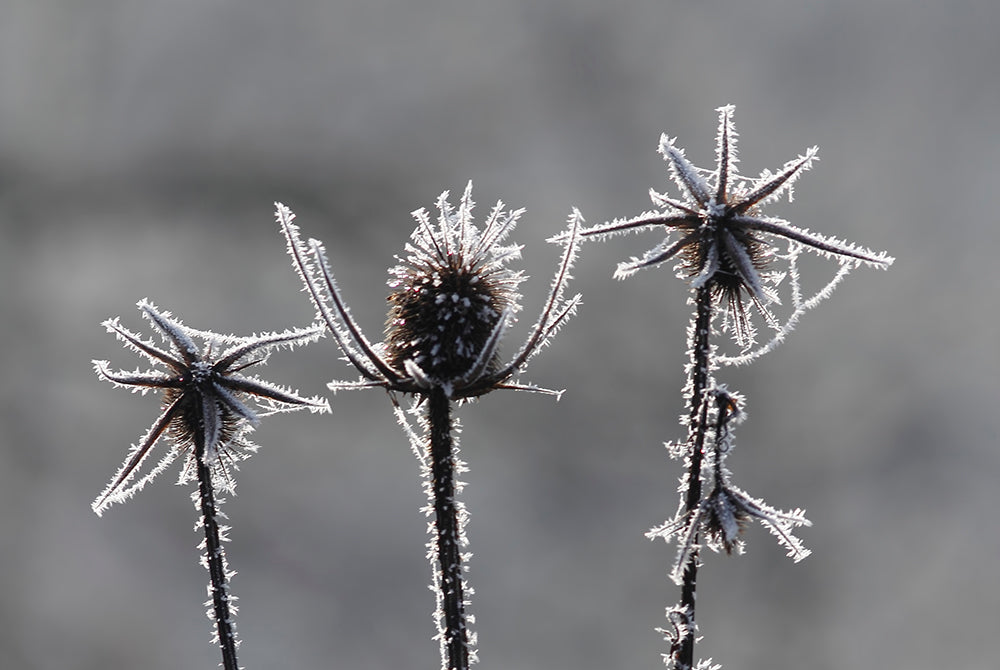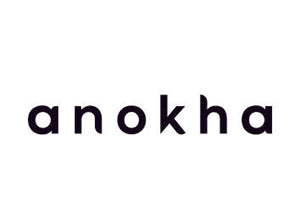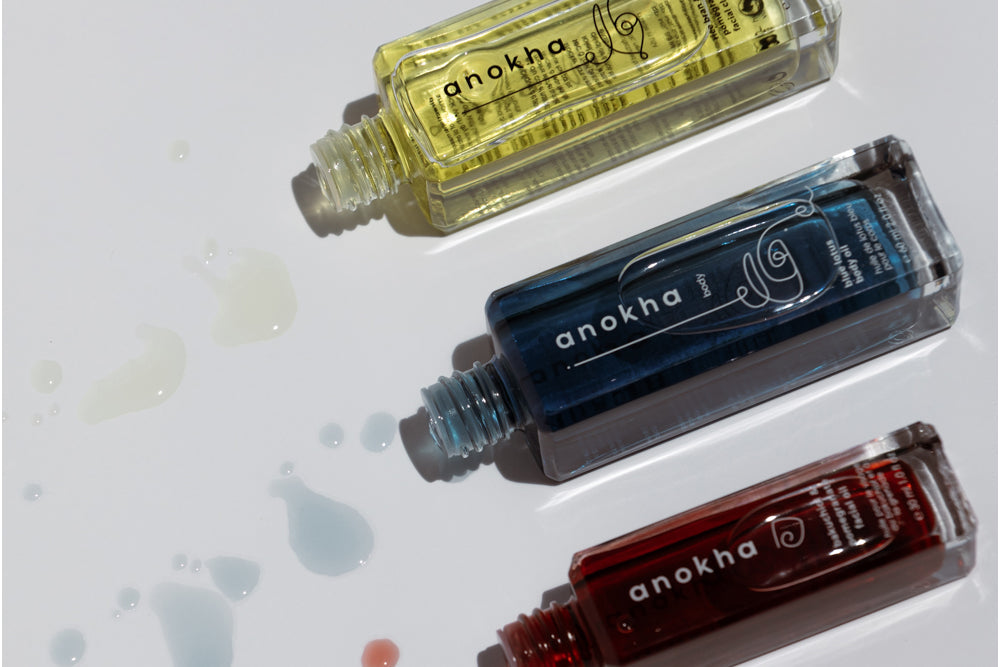article: ingredient focus: burdock root

ingredient focus: burdock root

the bottom line
Used therapeutically for hundreds of years in Europe, North America, and Asia, burdock root is believed to carry mystical powers including the ability to protect from negativity and evil. While it’s been valued for its cleansing and skin smoothing properties, it has gained interest as a key ingredient for use in hair tonics and skin treatments to relieve inflammation and promote wound healing. For more about the magic of burdock root, keep reading.
first layer: the history of burdock
Burdock root, or Arctium lappa, is a species from the Asteraceae family that is cultivated in China, Japan, Vietnam, Indonesia, the Philippines, New Zealand, and North America. As a biennial member of the Asteraceae family, burdock possesses bright pink to purple thistle flowers on long stalks, with large, heart-shaped hairy leaves. The plant itself can grow to a height of 9 feet, while its root can extend as far as 3 feet deep into the ground. The fruit, or bur, is capable of latching onto other plants and structures which facilitates the spread of its seed.
Burdock has a long history of use in western herbalism, and its therapeutic uses were documented in The Compendium of Materia Medica by Li Shizhen during the Ming dynasty. It is believed to balance internal heat, support skin health, and soothe mucous membranes. The root may be cooked to change its energetic properties while making it easier to digest. In western folk medicine, an infusion of the seeds has been used as a diuretic and in topical poultices.
The 17th century physician, herbalist and astrologer Nicholas Culpeper wrote of burdock in his Complete Herbal (1653), as did William Cook, author of the Physio-Medical Dispensatory (1869). Traditionally, burdock root has been thought to carry magical powers of protection and healing. In Turkey, burdock root may be used for protection from the evil eye and is sometimes woven into kilims for this purpose. Another traditional belief holds that wearing a necklace made from the root gathered during the full moon will protect the wearer from evil and negativity.
In a final fascinating historical note, burdock was the inspiration for Velcro, invented after Swiss engineer Georges de Mestral noticed the burs attached to his wool socks and his dog’s fur one day while walking in the mountains. After examining the barbed, hook-like seeds of the fruit he replicated the attachment action in his laboratory. In 1955, Velcro was patented and released worldwide.
second layer: the science of burdock
Rich in phenolic acids*, flavonoids*, polysaccharides*, and derivatives of unsaturated fatty acids including linoleic and oleic fatty acids, burdock root has demonstrated the following activity in scientific studies:
- anti-inflammatory activity: In one study, burdock root was shown to
inhibit nitric oxide* synthase expression and production, suppress cytokine* expression, activate antioxidant enzymes, and scavenge free radicals*. Another study showed that extract of burdock exhibits a dose-dependent anti-inflammatory effect on the release of both TNF-alpha*, which has been shown to impair collagen* synthesis, and IL-6*, which mediates the effect of collagen breakdown in the skin.
- anti-oxidant activity: A study in which extracts from the aerial parts and roots of burdock were examined showed significant antioxidant activity when compared to the control of ascorbic acid (vitamin C). The extracts also had high scavenging activity against hydrogen peroxide, a reactive oxygen species*, with the roots notably demonstrating greater activity than the aerial parts.
- collagen stimulation: A formulation containing 1.2% burdock root was shown to be significantly associated with procollagen* synthesis after 12 weeks of topical use. This is consistent with the study previously mentioned in which there were dose-dependent effects of burdock on the release of TNF-alpha and Il-6.
- antimicrobial activity: both antibacterial and antifungal activity have been demonstrated with the use of burdock root. Burdock leaf fractions have specifically been shown to inhibit the growth of Escherichia coli and Salmonella typhimurium.
- hyaluronic acid* production: In the above study, levels of hyaluronic acid were also noted to be significantly elevated following 12 weeks of use of the formulation containing 1.2% of an Arctium lappa extract.
third layer: burdock root for skincare
As a result of its remarkable activity, burdock root has also been studied specifically for its effects on the skin:
- wound healing: A study utilizing Arctium lappa polysaccharides for the treatment of diabetic wounds showed the acceleration of wound healing, promotion of collagen deposition and vascularization, decreased inflammation, and enhanced wound healing.
- acne: A biological study confirmed the anti-acne properties of an isolated peptide fraction from burdock root.
- fine wrinkle reduction: A 4-week treatment with a formulation of 1.2% Arctium lappa extract showed a significant reduction in wrinkle volume in the region of the crows’ feet around the eyes.
fourth layer: how we do it
We remain impressed by the quiet beauty and raw power of burdock. Burdock root is a key component of our lotus flower & rosewater toner. Layered with Lebanese rosewater and extracts of lotus flower, burdock root, and Centella asiatica, it provides balanced skin, bottled.
All of this and more at anokhaskincare.com.
xx
anokha
references:
- Skowrońska W, Granica S, Dziedzic M, Kurkowiak J, Ziaja M, Bazylko A. Arctium lappa and Arctium tomentosum, Sources of Arctii radix: Comparison of Anti-Lipoxygenase and Antioxidant Activity as well as the Chemical Composition of Extracts from Aerial Parts and from Roots. Plants (Basel) 2021; 10(1): 78.
- Chan YS, Cheng LN, Wu JH, Chan E, Kwan YW, Lee SM, Leung GP, Yu PH, Chan SW. A review of the pharmacological effects of Arctium lappa (burdock). Inflammopharmacol 2011 Oct;19(5):245-54.
- Knott A, Reuschlein K, Mielke H, et al. Natural Arctium lappa fruit extract improves the clinical signs of aging skin. J Cosm Dermatol 2008; 7: 281-289.
- Wlaschek M, Heinen G, Poswig A, Schwarz A, Krieg T, Scharffetter-Kochanek K. UVA-induced autocrine stimulation of fibroblast-derived collagenase/MMP-1 by interrelated loops of interleukin-1 and interleukin-6. Photochem Photobiol. 1994 May;59(5):550-6.
- Sato M, Ishikawa O, Abe M, Miyachi Y. Opposite effects of tumour necrosis factor-alpha on type I and III collagen gene expression by human dermal fibroblasts in monolayer and three-dimensional cultures. Br J Dermatol 1998 138(1):118-21.
- Xiang W, Wei J, Huang J, Kuo CF, Mei X, Xu S, Lu N. Injectable Arctium lappa polysaccharide-based composite hydrogel enhances diabetic wound healing. Int J Biol Macromol 2025 May;305(Pt 2):141285.
- Miazga-Karska M, Michalak K, Ginalska G. Anti-Acne Action of Peptides Isolated from Burdock Root-Preliminary Studies and Pilot Testing. Molecules 2020 Apr 27;25(9):2027.
- https://mountainroseherbs.com/burdock-root
- https:wikipedia.org/arctium
definitions:
collagen: a fibrous protein that forms part of the dermal matrix, connective tissue, cartilage, and bone
cytokine: cytokines are small proteins that are required to control the growth and activity of other immune system cells and blood cells. cytokines affect the growth of blood cells and other cells crucial to the body's immune and inflammation responses.
flavonoids: flavonoids are a diverse group of plant chemicals, or phytonutrients, found in almost all fruits and vegetables. like carotenoids, they help to give fruits and vegetables their vivid hues. flavonoids are powerful antioxidants that fight inflammation and help to support the immune system.
free radicals: an unstable molecule created during normal cell metabolism. free radicals can accumulate in cells, causing damage to other structures including DNA, lipids, and proteins.
hyaluronic acid: hyaluronic acid plays an important role in the human body and is involved in hydration and joint lubrication. its synthesis increases during tissue injury and wound healing, and it regulates specific aspects of tissue repair.
IL-6: interleukin-6 is a cytokine, a protein that plays a crucial role in inflammation and immune responses. it's involved in the breakdown of collagen in the skin.
nitric oxide: nitric oxide is a colorless gas which is one of the principal oxides of nitrogen. it is a free radical.
phenolic acids: phenolic acids are a key class of polyphenols which are natural antioxidants.
polysaccharide: a carbohydrate such as starch or glycogen whose molecules consist of several sugar molecules bonded together.
procollagen: procollagen is a precursor of the fibrous protein collagen.
reactive oxygen species (ROS): a type of unstable molecule that contains oxygen, and which can react with other molecules in a cell. they can damage DNA, RNA, proteins, and even cause cell death. also referred to as free radicals.
TNF-alpha: tumor necrosis factor is a pro-inflammatory cytokine produced by immune cells. it plays a crucial role in the body's inflammatory response to infection, injury, and autoimmune diseases, and has been shown to impair the formation of collagen in the skin.


leave us a comment
This site is protected by hCaptcha and the hCaptcha Privacy Policy and Terms of Service apply.